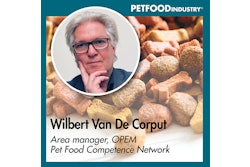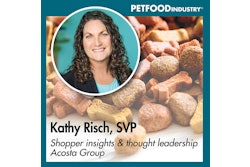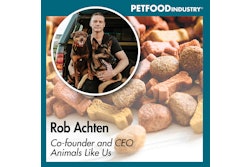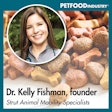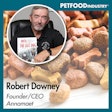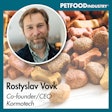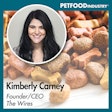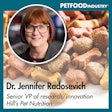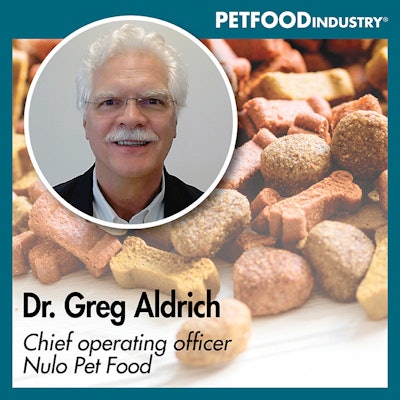
From traditional processing methods, like extrusion, baking and canning, to less-processed options, like cold-pressed technology, Lindsay Beaton and Dr. Greg Aldrich focus in on evolving pet food processing technologies and how they impact today's pet food industry.
The below transcript is from Episode 66 of the Trending: Pet Food podcast. Host Lindsay Beaton talks with Dr. Greg Aldrich, COO of Nulo Pet Food, about the latest pet food processing technologies, how they’ve evolved and what it means to the current pet food space. You can find the episode at Trending: Pet Food, on SoundCloud or on your favorite podcast platform. This episode originally aired on July 31, 2024.
We want to thank AFB International for sponsoring this podcast. AFB is the premier supplier of palatants to pet food companies worldwide, offering off-the-shelf and custom solutions and services that make pet food, treats and supplements taste great.
Lindsay Beaton – editor, Petfood Industry magazine, and host, Trending: Pet Food podcast: Hello, and welcome to Trending: Pet Food, the industry podcast where we cover all the latest hot topics and trends in pet food. I’m your host and editor of Petfood Industry magazine Lindsay Beaton, and I’m here today with Dr. Greg Aldrich, chief operating officer for Nulo Pet Food and now a repeat guest on the podcast. Hi Greg, and welcome back.
Dr. Greg Aldrich, chief operating officer for Nulo Pet Food: Lindsey, great to hear from you again and lovely to have an opportunity to visit.
Beaton: On the off chance you’ve not yet been introduced to Greg or Nulo, here’s what you need to know.
Before joining Nulo, Dr. Aldrich was an associate professor and director of the pet food program at Kansas State University. His research focused on characterizing the impact of pet food processing on dog and cat nutrition. He has authored 10 book chapters, 90 peer-reviewed manuscripts, delivered 325 presentations, and has written over 222 articles on pet food and ingredient topics for our own Petfood Industry magazine. In 2019 he received the Corbin Companion Animal Biology Award from the American Society of Animal Science. Dr. Aldrich received his Ph.D. in Nutrition from the University of Illinois, his M.S. from the University of Missouri, and his B.S. from Kansas State University.
Nulo Pet Food produces premium pet food and treats for dogs and cats. The company is a growth leader in the pet specialty channel with products ranging from high-meat kibble recipes to freeze-dried raw diets, human-grade bone broths and functional treats and supplements. Nulo also recently launched a line of cold-pressed, shelf-stable pet food.
Greg’s expertise in all things pet food processing, to say nothing of his unmatched experience in the pet food nutrition space, is why I’ve brought him on today to answer this question: How have pet food processing technologies evolved, and what do today’s technologies mean for the pet food space?
So, Greg, that's a very big question to try to answer. I want to start off with the first half of that question. You've been around a while, and you've been involved in processing technologies for a good long time. What are some of the ways pet food processing has changed over the years?
Dr. Aldrich: That's a big question and probably needs a whole history lesson. But let's hit a couple of topline points. Pet food as a commercial enterprise really started about 160 years ago with a baked product. Fast forward 100 years or so, in the 1950s -- 1953 I believe was the year -- when Nestle, or Purina at the time, had a couple of scientists. One of them was Jim Corbin, who that award is named after. They were the inventors of the extruded kibble-based pet food. Before then, it was sort of a meal or a muesli. Providing a commercial food for a dog, not so much cats, but for dogs, was sort of a hit-and-miss enterprise.
Once we get into the 1950s-60s, pet food started to emulate in many ways, some of the technologies that were being introduced for human foods. Canned foods, semi-moist products, more and more baked. That continued to evolve through about 1980-1990. Then we started to really focus more on the nutritional composition and a lot of the ingredients and how we process those moving into the 2000s. That's when we started to get products sold on what you have or what you don't have.
The natural products were really coming out in bold measure in the early 2000s. We got into selecting away from grains, and so the grain-free diets became popular. There's a whole host of processing, sort of recalibration, that had to go on during that period. In the last few years, we've had a full new era of raw, minimally processed bones and raw food or biologically appropriate raw food that Ian Billinghurst pioneered late 1990s, early 2000s that started to become something of interest to folks.
Whenever you get into raw, there's a lot of other questions regarding how we deliver that from a manufacturing facility to the home. There are several refrigerated, frozen and even home delivery options available today. The fresh refrigerated foods became in vogue.
I guess I want to recapture that rambling answer with this – simply that pet food mirrored or followed a lot of the processing trends associated with human foods as those new technologies became available. As homeowners and consumers became somewhat familiar with them, it wasn't too long before pet food would jump in and try to convert them into a nutritionally complete diet format.
Beaton: Now, I know that a lot of these different processing technologies are being used by competitors for different kinds of pet foods in the space. But what do you think are some of the benefits to the industry having access to all these different options? Has it really, in your view, evolved the industry to be more than it could have otherwise been? Is it good to have this much diversity when it comes to processing options?
Dr. Aldrich: Generally, yes. There's some value in coming at nutrition and food provision from a wide array of different angles. At the end of the day, we can feed all our dogs one single diet of a kibble, but that doesn't necessarily address all our personal desires and lifestyles.
One of the things we sometimes start to get into a discussion with dogs and cats is that this minimalist, utilitarian sort of approach of what is necessary for them, but in essence, they live in our homes. We need to accommodate and make it user friendly for pet owners so that they can provide sufficient nutrition or nourishment for their companion animal in a way that means the most effective for them. That's where I think the diversity of options gives us a chance to do that. I also think we're learning new things as we evolve into those different formats regarding nutritional requirements, bioavailability, even how they impact the animal's microbiome. We're seeing more and more information come out about how processing of the diet may influence the gut health. I think net-net is of benefit. It's a little noisy, and sometimes we missed the mark collectively in the industry. But you know, I think the net is positive in the nutrition of the animal and the pet ownership.
Beaton: What are some of the main strengths and weaknesses of the primary types of processing being used in the industry today?
Dr. Aldrich: Let's go to the traditional -- extrusion, baking, canning. Extrusion, on the positive side, is very cost effective, very high throughput. It's in essence a starch conversion machine. It does a phenomenal job of taking cereals, organs or tubers and cooking that starch, so it's nutritionally available and delivering it with the proteins and fatty acids, vitamins and minerals, in a nice crunchy agglomerated kibble so that the animal gets the proper nutrition in every bite. The challenge of it is we're going through a harsh process regarding some of the molecular structure of those food products. These get ripped and shredded with this process called shear -- that grinding, mixing motion.
We're adding a lot more heat than is necessary to some of the components while we're trying to cook the starch. We're also trying to get it to where we've eliminated any pathogens. It's a plus-minus sort of thing. It’s a great process, we use it, it's 70% of the pet market, it’s terribly convenient. I think it's here to stay. I think most of where we're going with pet space is options relative to that for some of those folks that want a different experience. So, that's extrusion.
Canning, similar sort of thing is high meat, so a very little bit of starch. If you're a carnivore philosophical nutrition person, you're going to want to do something with some higher-end meat. Canned wet foods and pouches and trays and chips all fit into that category. The challenge is we're heating the product to a very high temperature for a long period of time to get pathogen control. In the process of that, we're overcooking certain components of the diet and may produce some things that are negative. The story for can, by and large, is it’s very readily accepted.
One of the things that most of the veterinary community would identify as a negative about canning is that it's going to have a high amount of water. You're buying a lot of water. We're pushing water around in various ways, and that's expensive. The other is that you don't get much abrasive action during the eating experience, so there's concern there about dental plaque and tartar. But it's quality way of providing nutrition. We’re learning more every day about how we can optimize that process.
Baking is very similar to extrusion. It's just a much slower process. We're cooking the starches. We're creating some flavor development of the surface of the product, browning reaction during that high-heat baking process. The biggest challenge for baking is just that it's very slow relative to extrusion.
You have two formats that are almost identical: baked versus extruded. Baked is, I don't know, maybe a 10th of the efficiency and production. The cost per unit is higher for roughly the same nutrition.
Those are the three categories, pluses and minus for all of them. They are very popular formats across the board. There are ways in which people can talk about their nutritional adequacy. I think the net-net, though, where we're moving in the current area is to less processed, and all those traditional methods would be considered highly processed.
Beaton: Let's talk about the less processed options out there. We are going to transition into talking about the cold-pressed technology, because I'm very interested to learn how it crossed over from the human space into pet food. But what has the industry been doing? And what are some of the benefits and challenges of the less processed formulations?
Dr. Aldrich: We can go to the full extreme on less processed. That would be the raw diets, bones and raw food. On one hand, I get it. It's certainly something that would be an ancestral throwback to an earlier age, when dogs and cats had to fend for themselves. Certainly, they can get the nourishment they need. I've seen some studies in which the nutritional bioavailability and the animals’ markers or health are equal to or better than on a conventional processed diet. It's certainly what the animals evolved to be adapted to consume.
The challenge we have is that post 2007 with the FDAAA act and Food Safety Modernization Act that followed out of that, many of those raw diets, because they're not processed, may harbor pathogens like Salmonella. That can become problematic in a commercial setting when we're trying to move product from a manufacturing facility to retail to home.
Also within the home, the idea that we would get some cross-contamination, especially in in homes where we have people that are at risk health wise. There’s a big concern regarding safety with those diets. I also would point out that for those folks that are preparing them at home, unless they've got a sufficient level of skill and knowledge, there's a high probability we're going to get into some nutritional deficiencies. At some point, even some toxicities that they may not understand until it's too late. I'm not trying to be elitist here. Certainly, folks can do that kind of thing at home. They feed themselves. If they become students of companion animal nutrition for their individual animal, they can probably teach themselves, but it's a lot of investment in time and energy.
In our society, I see folks not spending as much time educating themselves on their foods and nutrition for their own benefit, let alone for the companion animal. There's always that challenge. That’s the extreme edge of the platform. There are some other foods out there in the refrigerated case. They've been mildly processed and somewhat shelf-stable under cold storage. Those are fine products. The challenge for them is just shelf life, anywhere from 10 to 14 weeks. There’s got to be a restocking and replenishment system in place. They're relatively high priced, and they may or may not provide for some of the elements of a dog’s or cat's diet, especially dogs.
I'm a dog owner. My dog likes to chew on bones and other things. Those refrigerated foods get consumed rather voraciously. I don't even think he tastes it in some cases. There’s some element to forcing them to slow their consumption and crunch on something. I am concerned from a food management standpoint; some dogs may not be adapted to those because they're extraordinarily palatable.
There are frozen diets as well. What we're trying to get to, and I think that some of the newer things in the marketplace are shelf-stable and convenient. It's a full meal. It fits a lot with other food management practices of the traditional kibble, but in a format that's less processed so that one can feel like they're almost feeding a raw diet, yet not having concerns over pathogens. We're not going to have over-rapid consumption, where they end up with pancreatitis or something along that line. It's in a format that you can just pick up the bag and take it home without the fatigue and challenge associated with managing the food in the home for another being out of your hands. It also makes it easier to participate with that food prep.
Beaton: Where does cold-pressed technology fit into all this?
Dr. Aldrich: I've been in pursuit of this for the last 15 years when I joined the university back in 2010-11. I was doing a lot of work on processing for various groups, and I continued that through into my academic activities. What I was always trying to do is identify the perfect pet food. I can spin a short story about it.
The idea is that certain elements in the diet need processing, and certain elements in the diet need minimal processing, and others need none. In human foods, we address that because we have certain corners of our plate that we will provide something that's minimally cooked, or our potatoes may be baked, or our steak may be gently fried or barbecued. The idea that we're separating or isolating our diet into meals; our meals into components that are all coming together on our plate. Some of them are cooked to certain levels so that we get the ideal amount of nutritional conversion, flavor and texture necessary to give us a good experience.
In pet food, we tend to throw all that together into this mix. Then we run it through a machine or apparatus to cook, so that the item that needs the most cooking, your preparation gets what it needs, and everything else, it doesn't matter, we know that it's cooked.
In that case, we end up with too much temperature and time on proteins that don't need it or vitamins with high levels of oxygen that are flowing across. What we’re looking at in the cold-pressed category is can I get to a point where I get just the right amount of heat? I remember back years ago, McDonald's had the McDLT with the hot side hot and the cold side cold. Is there a way in a single food item as a diet for dogs or cats that we can create a combination of processes and ingredients where the things that need cooked are and the things that are not being cooked are not?
We've built a couple of different products, the cold pressed is one of an array of several, in which we're trying to optimize the level of temperature necessary to not only form the product and get it into the shape that we want, so it's got a good experience in the bowl. But also when it's dried and shelf stable, it's convenient for the pet owner and doesn't have a 10-week shelf life. I can go to a year on the shelf and we can address the needs as a supply chain. It's trying to find that perfect combination of process, ingredient, timing and keeping a shelf-stable food. That's where that all came from. I've been at it for about 15 years. I'm getting closer, let me put it that way.
Beaton: What does that look like from a practical standpoint? Do you have to process the different ingredients in different ways and then merge them all together at the end? Or can you use a single process that does all the necessary things to all the parts at the same time?
Dr. Aldrich: The short answer is if it's a complex diet, where I've got starches and I've got proteins and fats, it makes it difficult to do it into singular process. But if I remove or decrease one of those three major components, then I can probably get to a singular process. Let me walk that out.
We have a product category that we call Raw Plus where we are creating freeze-dried components that are meat based. That element is not receiving high temperature. The proteins are being converted; the vitamins and the minerals are being protected. We don't have a lot of heat in there. Then we have a starch component that goes through mild extrusion as a sole ingredient so that we don't have to overcook it. Those components are then pieced together.
That’s if I have starch as part of the component. It's a sweet potato shred that we've gone through the cooking process, so it's converted. The cold press is another iteration of a similar process, but we have very little to no starch in there. It's almost completely meat. It's 85% meat, vitamins, minerals, a little bit of apples and sweet potatoes as a compliment. Otherwise it's 95% meat proteins.
Beaton: What is it about starch that seems to make things more complicated? Is it a bioavailability issue? Does it need to be cooked for accessibility reason?
Dr. Aldrich: It is a bioavailability issue. Starch is amylose and amylopectin, which are long chains of glucose. They need to be converted. In a cereal, for example, or a tuber, they're in an organized fashion. They must be disorganized, and that disorganization process is called gelatinization – the process of heating starch, causing the starch granules to swell and burst. Those glucose molecules that are part of that granule of starch are then susceptible to the amylase enzymes in your intestine, which makes it available.
The reason we cook starch -- the reason you make pancakes or you bake your potato – is so you can unlock that glucose in your digestive system and get the energy out of it. If we feed a raw starch, digestibility goes down substantially. Some of that is good, because we get a little escape of that starch to the colon, where it can be resistant starch and behave a little bit like a fiber. But if we get too much starch escaping digestion, then we can end up with diarrhea. As is all nutrition, it's about balance. A little is right, a lot is not. It's just finding that right tipping point. So, we cook starch so that we can unlock those bonds.
Beaton: You said you've been working on this for essentially 15 years trying to find this perfect process the perfect way to make all of this happen? How exciting or fun has it been to be able to work on this and make this kind of progress after working on it for so long? Has it been an exciting prospect to introduce cold-pressed technology to have something new happening just to see the results of it?
Dr. Aldrich: I guess the short answer is yes. For me, it's been very gratifying to take some of the work that we did at the university that was very academic in nature and some of the ideas that I had that never quite made it to the laboratory, and to bring it into a product that goes into commerce, generates some excitement and some enthusiasm, and to see some of your ideas materialize.
I have enjoyed each facet of my career, and I enjoyed being at the university. This is one of those that gave me a new opportunity to apply some of those findings and to see whether … I mean, I knew they were going to be successful from a technical standpoint. Now I'm hoping to see whether they're accepted that way from a commercial standpoint. This has afforded me a real opportunity to do that. Not everybody gets that chance.
Beaton: I know you're not in the marketing business, but what has the initial reaction been from a consumer perspective? How much education is required for this type of processing to be accepted? Or is that not a primary concern for pet owners?
Dr. Aldrich: It's a big concern. And I'll be frank with you, Lindsay, the jury's still out. This product we launched at Global Pet, we wanted to get the enthusiasm and excitement of retailers in the independent pet market. We've positioned it with them as the primary conduit to the marketplace. I think we accomplished that. We were very busy during the entire trade show, communicating to them what this new opportunity was. I think there's a bit of buzz associated with their interest. They're the ones that are going to communicate and train the consumer.
On the heels of that, we're looking at ways in which we can communicate to the consumer what the value proposition is here. It's going to look a little bit like kibble, but the pricing is going to be much higher. One of the first questions that we always get asked is, “Where do you position this product relative to everything else in our stores?”
My short answer, although it's not been vetted officially here in the organization, but my short answer is, “This is a real opportunity for something to help consumers afford a product that's like freeze-dried or raw or refrigerated. From a nutritional standpoint, it has roughly the same kind of nutritional composition and bioavailability, yet it's in that convenient format. On a cost /day feeding, it's going to be about 30% to 50% less.”
It's really in that sweet spot. Communicating that -- because it's really a new category in and of itself -- is going to be a little bit of a challenge. That's why we've been trying to create a new way is to better articulate and communicate to folks where they are. We'll find out here in the next few weeks whether it's truly successful, it should be in stores right about now.
Beaton: Excellent. And right about now, as we're recording this, is mid-May just after Interzoo. Did you promote this at all at Interzoo? Or is it not something that's going to show up overseas?
Dr. Aldrich: We did not promote this product category at Interzoo. We went with a more traditional product line-up. Interzoo was sort of our first foray into Europe and into Asia. Nulo has been primarily a North American company, addressing the needs of our marketplace here in the U.S. and in Canada. Starting this last year, we're beginning to explore other regions of the world to see if our products will translate into their marketplace. It's a brave new world for us. Interzoo was the first time we really had a chance to showcase our products in the way we present in retail, to another market outside of the U.S.
Beaton: As a wrap-up question, I want to talk about the future. What are you most looking forward to seeing in terms of pet food processing advancements? What is your next step as a scientist and as a nutrition expert?
Dr. Aldrich: I'll be a bit vague about that. What I see for the future is a continuation of what we've been exploring regarding this minimally or optimally process. I really liked the idea of making it safe and convenient and nutritionally complete for the pet owner -- and shelf stable. But I'm not going to take anything off the table.
The idea of identifying the optimal process, both time temperature and component is something that I don't believe I've gotten there completely yet. I'm probably going to spend a little bit more time. Nulo’s investigating and investing in additional product offerings that continue to amplify and accentuate that optimal process, so that we can get a better value proposition for the pet owner and continue to improve their lives, not just in the U.S., but all the way around the world.
Beaton: Well, thank you so much for being on today, Greg. Between the increased complexities of pet food needs and innovation in the pet food space, I think it's safe to say processing technologies are getting quite the workout these days in terms of variety and needs.
It's been great to talk about everything happening, especially hearing it from you because you have been up to your eyeballs in processing as things have evolved over the years. Before we go, I want to do a little plug. Where can people find more information about you and about Nulo?
Dr. Aldrich: Folks can find more information about Nulo and all our exciting products at Nulo.com. We hope you'll come visit us and learn about some of the initiatives we have underway. And checkout Nulo’s Fuel Incredible campaign.
Beaton: Thank you so much. That's it for this episode of Trending: Pet Food. You can find us on petfoodindustry.com, SoundCloud or your favorite podcast platform. You can also follow us on Instagram @trendingpetfoodpodcast. And if you want to chat or have any feedback, I'd love to hear from you. Feel free to drop me an email: [email protected].
And of course, thanks again to our sponsor AFB International, the premier supplier of palatants to pet food companies worldwide, offering off-the-shelf and custom solutions and services that make pet food treats and supplements taste great.
Once again, I'm Lindsay Beaton, your host and editor of Petfood Industry magazine, and we'll talk to you next time. Thanks for tuning in!



